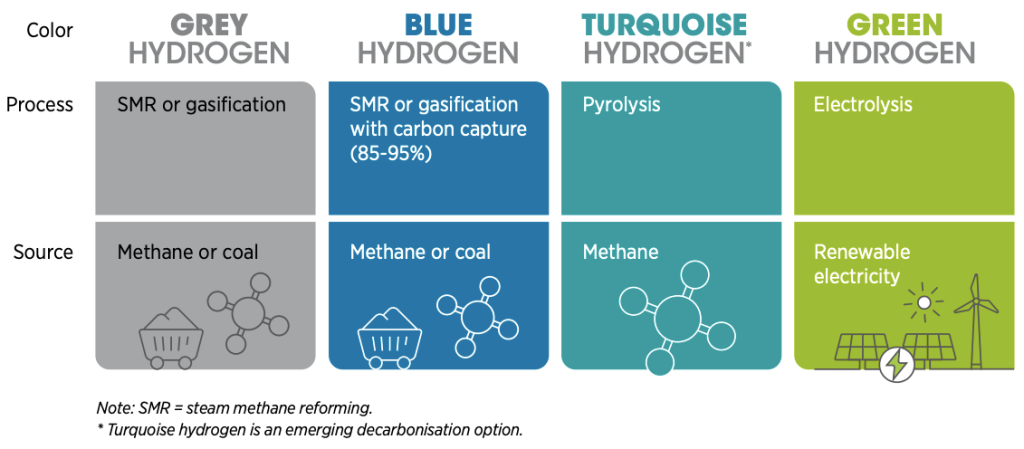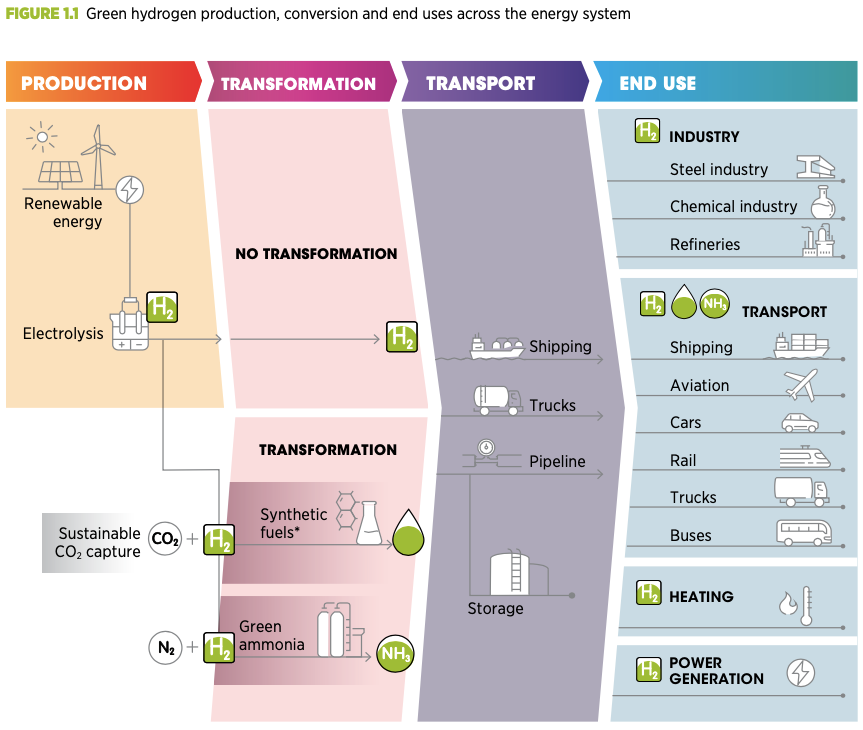
National Green Hydrogen Mission
Green hydrogen refers to hydrogen produced through the process of electrolysis using renewable energy sources like wind, solar, or hydroelectric power. It is often considered a clean and sustainable energy carrier since it does not release carbon dioxide or other greenhouse gases when used as a fuel.
The production of green hydrogen involves splitting water molecules (H2O) into hydrogen (H2) and oxygen (O2) using electricity. Hydrogen can be produced in a variety of ways on an industrial scale. These include coal gasification, oil reforming, and natural gas reforming using steam.
A limited amount is also created using more energy-consuming techniques, including water electrolysis. In order to identify these processes based on their carbon footprints, the hydrogen created via these ways has been given a variety of distinct names. Grey hydrogen is traditionally created by splitting methane (CH4) into carbon dioxide (CO2, a greenhouse gas) and hydrogen using steam.
As coal is used more frequently to make grey hydrogen, the amount of CO2 emitted per unit of hydrogen produced increases dramatically. Today, it is produced on an industrial basis. It has no utility for energy transition.
Similar to grey hydrogen, blue hydrogen uses the additional technology required to capture and store the CO2 that is produced during the separation of hydrogen from methane (or from coal). It is impossible to capture all of the CO2 produced, and not all methods of long-term storage are equally efficient.
Source: WEF, IRENA
Benefits:
The benefits of green hydrogen include:
- Renewable Energy Storage: Green hydrogen can store excess renewable energy generated during periods of low demand or high production. This stored energy can be utilised later when demand is high or renewable sources are unavailable, helping to balance the electricity grid.
- Decarbonization of Various Sectors: Green hydrogen can be used as a substitute for fossil fuels in various sectors such as transportation, industry, and heating. By replacing fossil fuels with hydrogen, these sectors can reduce their carbon emissions and contribute to the mitigation of climate change.
- Energy Sector Integration: Green hydrogen has the potential to integrate different energy sectors. For example, excess renewable energy can be used to produce green hydrogen, which can then be utilised in fuel cells to generate electricity or as a feedstock in industrial processes.
- Flexibility and Versatility: Green hydrogen can be used in a wide range of applications. It can be directly used as a fuel in fuel cell vehicles, blended with natural gas in existing gas pipelines, or used as a raw material for industrial processes such as ammonia production or steelmaking.
- Air Pollution Reduction: Hydrogen combustion does not produce harmful pollutants like nitrogen oxides (NOx) or particulate matter. Therefore, using green hydrogen as a fuel can help reduce local air pollution, leading to improved air quality and public health benefits.

Source: WEF, IRENA
- Energy Independence: Green hydrogen production reduces dependence on fossil fuel imports, making countries more self-sufficient in meeting their energy needs. This can enhance energy security and reduce geopolitical risks associated with fossil fuel supply chains.
However, it's important to note that the widespread adoption of green hydrogen still faces challenges such as high production costs, limited infrastructure, and technical feasibility. Nevertheless, ongoing research and development efforts are focused on addressing these challenges and improving the overall viability of green hydrogen as a clean energy solution.
National Green Hydrogen Mission
- The Green Hydrogen Policy, 2022 was introduced by the government in February 2022 and aims to increase the prominence of clean fuels in the nation's energy mix, which currently relies heavily on fossil fuels. A sum of ₹17,490 crores have been set out for the SIGHT program, ₹1,466 crores for hydrogen hubs and pilot projects, ₹400 crores for R&D, and ₹388 crores for other Mission components.
- The National Green Hydrogen Mission's goal is to encourage the commercial production of green hydrogen and turn India into a net exporter of the fuel by fostering export prospects. In an effort to lessen reliance on imported fossil fuels, the Mission also aims to decarbonize the energy industry, utilise it in mobility applications, and build up domestic manufacturing capabilities. Additionally, it will aid in the development of new technologies like effective fuel cells and employment possibilities.
- The mission has set a goal to build a capability for producing green hydrogen of at least 5 MMT (million metric tonnes) annually. Along with this, the nation's renewable energy capacity has increased by roughly 125 GW (gigawatt).
- The Mission is expected to contribute to investments of INR 8 trillion and the creation of more than 6 lakh employment by 2030, according to the government. The strategy is to target reduced prices of renewable power generation and to bring down the cost of electrolysers to make the production of Green Hydrogen cost-competitive through implicit subsidy assistance and a government-backed R&D effort.
- The Green Hydrogen Mission is divided into two overarching sub-missions: The Strategic Interventions for Green Hydrogen Transition Programme (SIGHT) will provide funding for domestic electrolyser production and green hydrogen; additionally, it will assist pilot initiatives in new end-use industries and supply chains. States and areas that can sustain large-scale hydrogen generation and/or use will be found and developed as Green Hydrogen Hubs.
Challenges:
While green hydrogen holds promise as a clean and sustainable energy carrier, there are several challenges that need to be addressed for its widespread adoption. Some of the key challenges include
- High Cost: Green hydrogen production is currently more expensive compared to hydrogen produced from fossil fuels. The cost of renewable energy sources, electrolysis equipment, and infrastructure contribute to the high production cost. As a result, making green hydrogen cost-competitive with conventional hydrogen is a significant challenge.
- Scaling Up Infrastructure: Establishing the necessary infrastructure for green hydrogen production, storage, transportation, and distribution is a substantial undertaking. It requires significant investments in electrolyzers, hydrogen refuelling stations, pipelines, and storage facilities. Scaling up the infrastructure to support large-scale green hydrogen deployment is a considerable challenge, particularly in regions where the necessary infrastructure is lacking.
- Limited Renewable Energy Availability: The availability and intermittency of renewable energy sources can impact the consistent production of green hydrogen. If the renewable energy supply fluctuates or is not sufficient to meet demand, it can limit the production capacity and reliability of green hydrogen.
- Energy Efficiency: The process of converting renewable electricity into hydrogen through electrolysis has energy efficiency limitations. The overall efficiency of the process depends on various factors such as the type of electrolyzer, operating conditions, and system losses. Improving the energy efficiency of electrolysis is crucial to reduce costs and optimise the use of renewable energy.
- Storage and Transportation: Hydrogen has a low energy density, which poses challenges for its storage and transportation. It requires special infrastructure and safety measures, such as high-pressure tanks or cryogenic storage, to store and transport hydrogen efficiently. Developing cost-effective and safe storage and transportation solutions for hydrogen is a significant challenge.
- Technological Development: Advancements in electrolysis technology are necessary to make green hydrogen production more efficient, scalable, and economically viable. Research and development efforts are ongoing to improve electrolyzer performance, reduce material costs, and increase durability.
- Regulatory and Policy Framework: Establishing supportive regulations, policies, and standards for green hydrogen is crucial to create a conducive environment for its adoption. Policy gaps, inconsistent regulations, and the absence of a comprehensive framework can hinder investment and deployment of green hydrogen projects.
- Public Acceptance: Creating awareness and fostering public acceptance of green hydrogen is essential. Overcoming scepticism and addressing concerns related to safety, infrastructure, and cost will be crucial to gaining public trust and support for green hydrogen initiatives.
Addressing these challenges requires collaborative efforts among governments, industry stakeholders, researchers, and investors. Continued research and development, technological advancements, cost reduction, and supportive policies are key to unlocking the full potential of green hydrogen as a clean and sustainable energy solution.
Way forward:
- Cost Reduction and Efficiency Improvements: Continued research and development efforts should be directed towards improving the efficiency of electrolysis technologies, reducing the cost of electrolyzers, and exploring new materials and catalysts. This will help drive down the production cost of green hydrogen and make it more competitive with conventional hydrogen and other energy sources.
- Scaling Up Renewable Energy Capacity: Expanding the capacity of renewable energy sources such as wind and solar power is vital for ensuring a consistent and ample supply of clean energy for green hydrogen production. Investments in renewable energy projects, grid integration, and storage technologies can enhance the availability and reliability of renewable energy, thereby supporting the growth of green hydrogen.
- Infrastructure Development: Building a robust infrastructure for green hydrogen is crucial. This involves establishing hydrogen production facilities, storage systems, transportation networks, and refuelling stations. Collaborative efforts between public and private sectors, along with supportive policies and incentives, can drive the development and deployment of hydrogen infrastructure.
- Cross-Sectoral Integration: Exploring opportunities for cross-sectoral integration of green hydrogen is important. This involves identifying sectors where hydrogen can have a significant impact on decarbonization, such as transportation, industry, power generation, and heating. Encouraging collaborations and partnerships between stakeholders from different sectors can drive innovation, foster technology transfer, and create synergies.
- Supportive Policy Framework: Governments can play a crucial role in creating a favourable policy environment for green hydrogen. This includes developing supportive regulations, setting targets, providing financial incentives, and facilitating public-private partnerships. Long-term policy stability and a clear roadmap for the transition to green hydrogen are essential to attract investments and drive market growth.
- International Collaboration: Collaboration at the international level is important for sharing best practices, knowledge exchange, and joint research and development efforts. International cooperation can help accelerate the development of green hydrogen technologies, establish common standards, and promote trade and investment in green hydrogen.
- Public Awareness and Acceptance: Educating the public about the benefits and potential of green hydrogen is vital. Raising awareness about its role in decarbonization, air pollution reduction, and energy security can help garner support and build public acceptance. Engaging with stakeholders, addressing safety concerns, and promoting the benefits of green hydrogen in terms of job creation and economic growth can foster public buy-in.
Overall, a comprehensive approach that combines technological advancements, supportive policies, infrastructure development, and stakeholder collaboration is key to realising the full potential of green hydrogen as a clean and sustainable energy solution.
